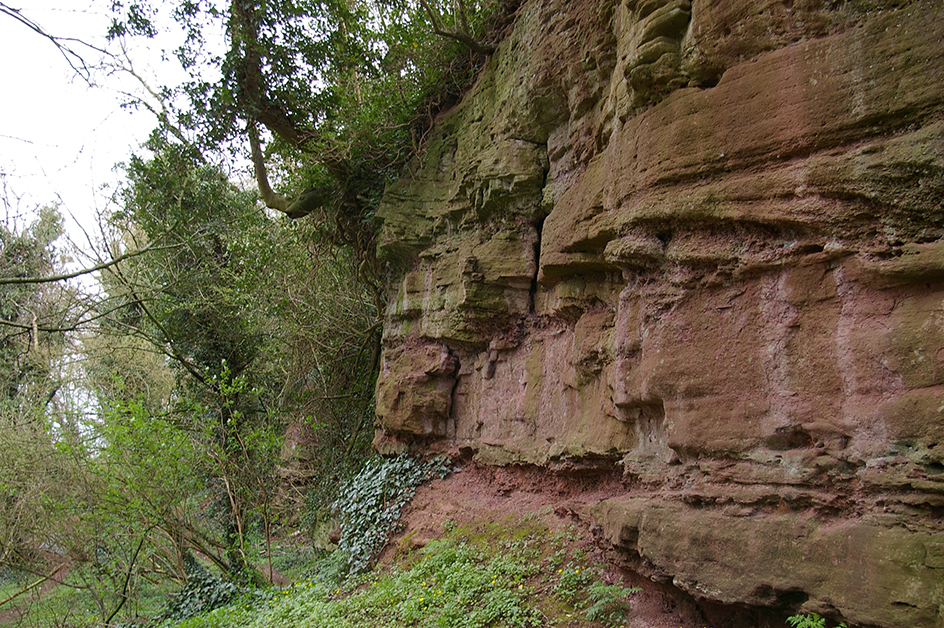
exposure of Old Red Sandstone
The Old Red Sandstone, which gives the characteristic colour to the local soil, was laid down by rivers crossing a broad flat semi-arid tropical plain to the south of the equator in the Devonian period, 400 to 350 million years ago. Here and there, meanders of the River Wye have exposed this rock as cliffs. Elsewhere it lies just below the surface of the ground. The red colour is due to the presence of oxygen during the creation of these rocks - these sandstone layers have been described as the 'rust of the earth'. Primative vertabrates in the area at the time inluded jawless fish: Hemicyclaspis murchisoni.
The oldest rocks were formed in the Pre-Cambrian ages. This is the supereon of geological time from the formation of the earth, around 4,500 million years ago, to the evolution of hard-shelled animals in the early Phanerozoic - 'revealed life' - some 545 million years ago, and so covers 88% of the earth's history. Pre-Cambrian strata are buried beneath more recent layers of sedimentary rocks and are often referred to as 'basement'. Here and there, these ancient rocks are visible on the surface, such as the outcropping Pre-Cambrian rocks of the Malvern Hills on the eastern edge of Herefordshire.
Most things which have happened on Earth happened during the Pre-Cambrian - four thousand million years is a long time - the Earth formed, tectonic plates developed, the atmosphere was formed and life evolved

Hemicyclaspis murchisoni fossils
By far the greater part of the visible geology of Herefordshire was originally formed in the Palaeozoic, the first era of the Phanerozoic eon. The word Palaeozoic means 'old animals' and the era lasted from 545 to 252 million years ago and is divided into six periods. The earliest rocks in the series were first identified in Wales and so the ancient name for Wales - Cambria - is used for them. (Hence, the term Pre-Cambrian for earlier rocks.) The Cambrian was followed by the Ordovician (named for the Ancient British tribe of central Wales) which saw the replacement of many of the life-forms of the Cambrian with newer ones. This seems to have followed a major extinction event - the Cambrian-Ordovician extinction.
The Ordovician was followed by the Silurian (named for another Ancient British tribe) which was followed, in turn, by the fourth period in the Palaeozoic era, the Devonian.
The era that followed the Palaeozoic was the Mesozoic, meaning 'middle animals', and the era is sometimes known as the 'Age of the Dinosaurs'. Rocks of the Mesozoic's three periods - Triassic, Jurassic and Cretaceous - are now absent from Hentland, having been eroded away.
The uppermost strata of the Old Red Sandstone at Hentland is the Early Devonian St Maughans Formation. The formation comprises a mix of red-brown, green or purple mudstones, sandstones, conglomerates and calcretes, which are superficially similar to the lithologies of the Raglan Mudstone Formation beneath. The sandstone bands have been quarried for flagstone and, where thick enough, for dimension stone (natural stone or rock that has been selected and finished (e.g., trimmed, cut, drilled, ground, or other) to specific sizes or shapes).